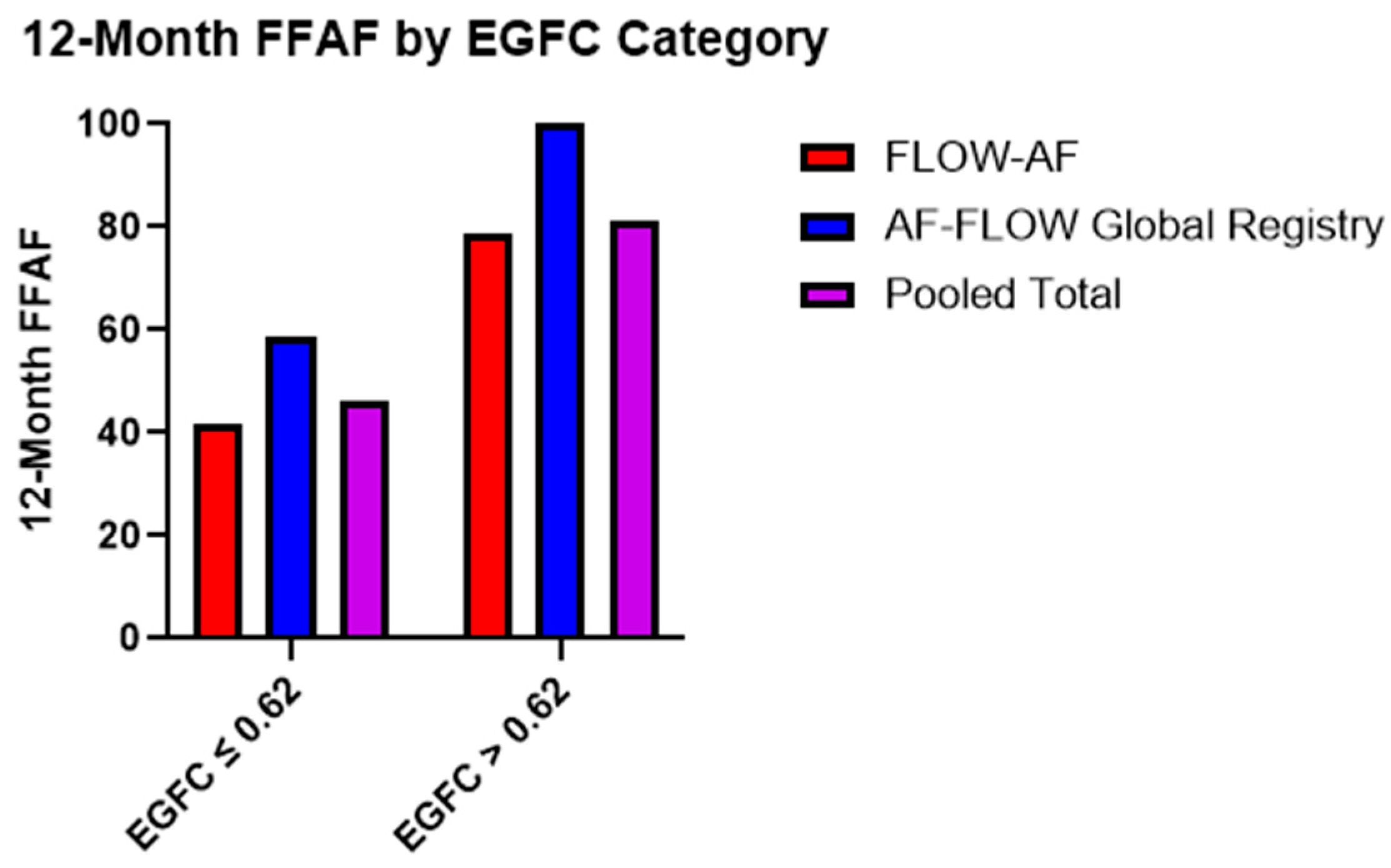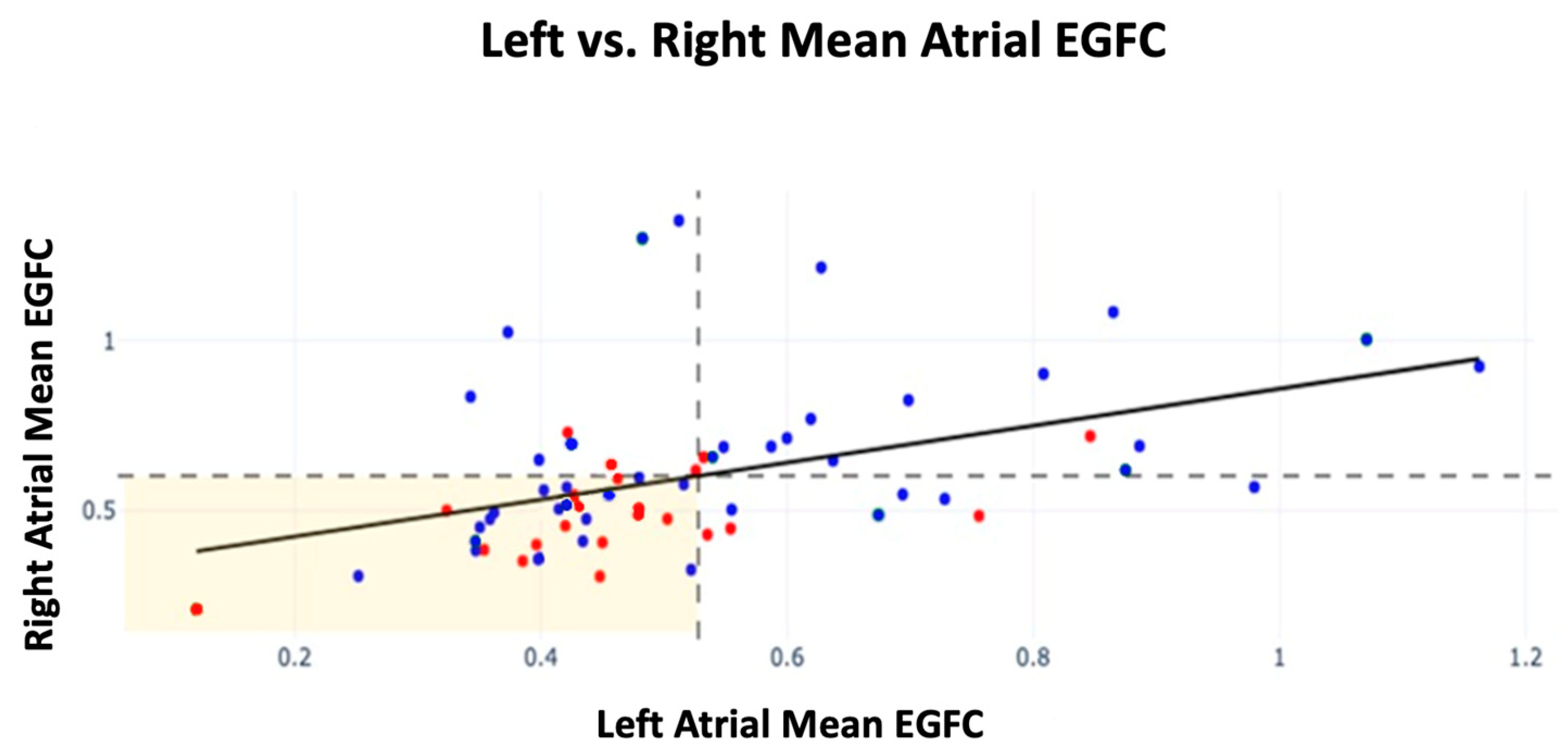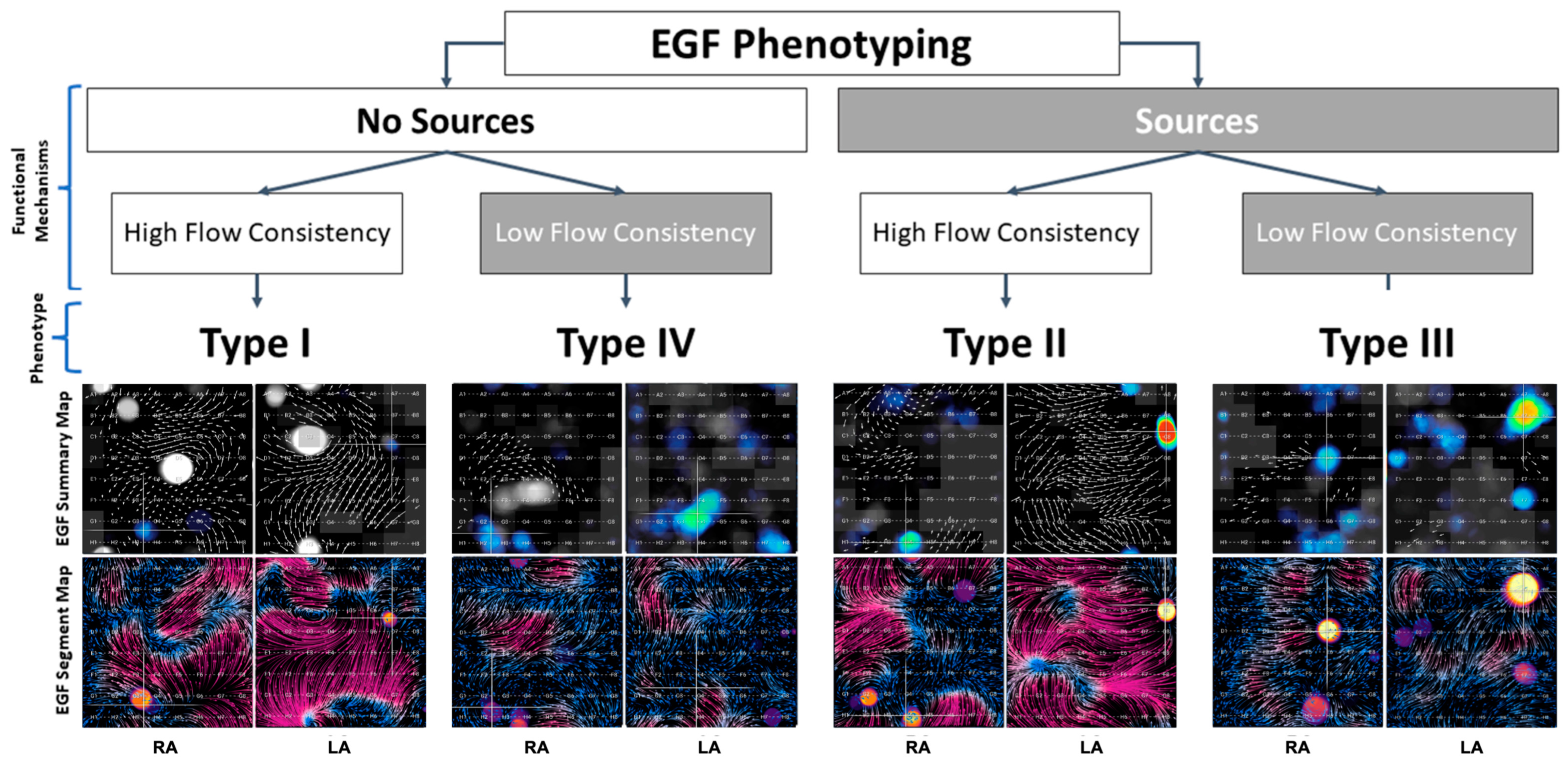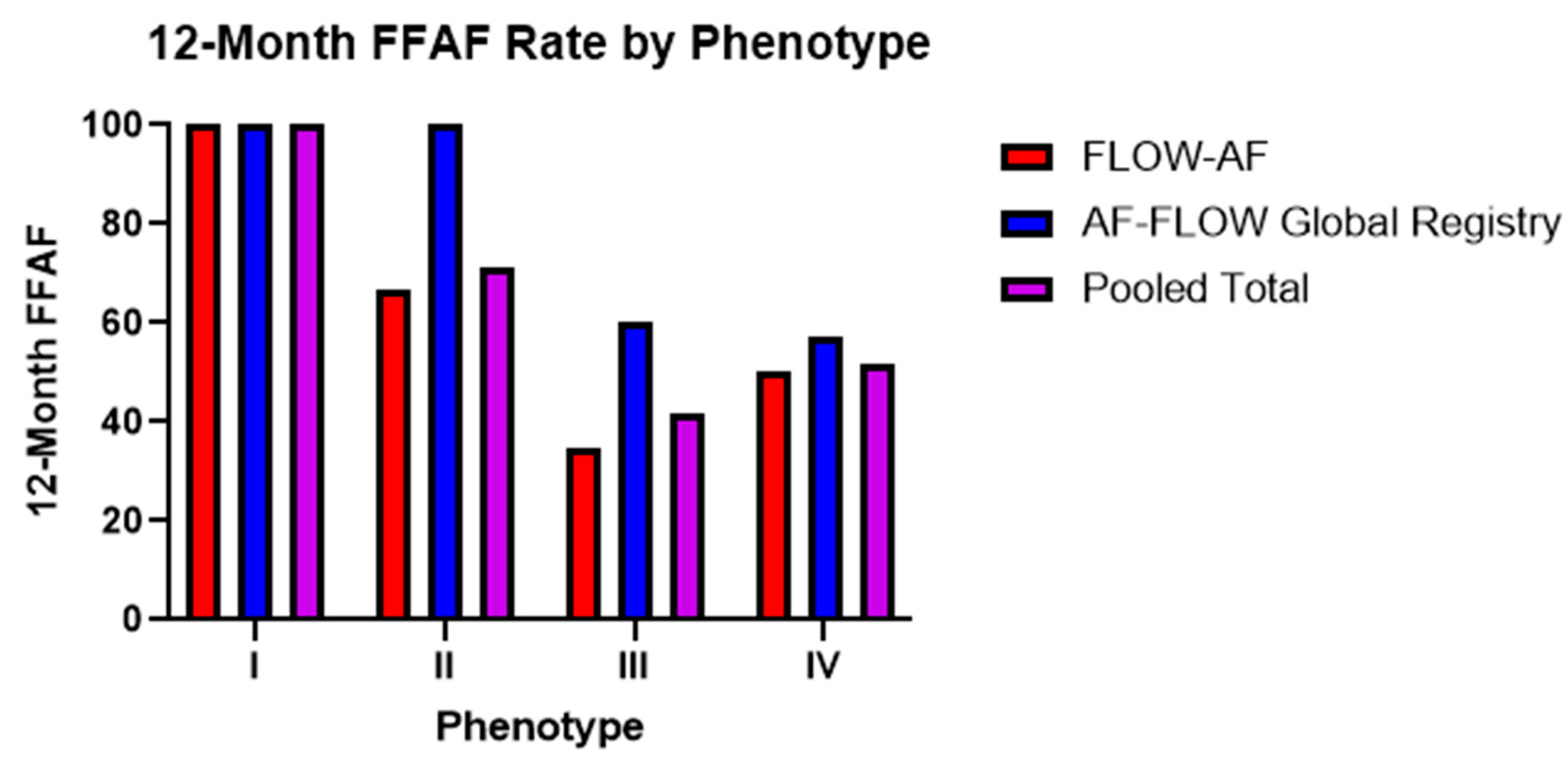Electrographic Flow Mapping Provides Prognosis for AF Ablation Outcomes Across Two Independent Prospective Patient Cohorts
Abstract
1. Introduction
2. Materials and Methods
2.1. Trial Overview
2.2. PVI Ablation Procedure
2.3. EGF Mapping
2.4. EGF-Guided Ablation
2.5. EGFC Calculations from EGF Maps
2.6. Statistical Analysis
3. Results
3.1. Trial Design and Demographics
3.2. EGFC Was Related to AF Recurrence Rates Across All Patient Cohorts
3.3. Phenotyping by EGFC and Source Presence Can Aid in Predicting Procedure Outcomes
3.4. Source Ablation Improves FFAF in Both Independent Studies
4. Discussion
5. Conclusions
Author Contributions
Funding
Institutional Review Board Statement
Informed Consent Statement
Data Availability Statement
Conflicts of Interest
Abbreviations
| AF | Atrial fibrillation |
| AFL | Atrial flutter |
| AT | Atrial tachycardia |
| EGF | Electrographic Flow |
| EGFC | Electrographic Flow Consistency |
| EGM | Electrogram |
| FFAF | Freedom from atrial fibrillation |
| LA | Left atrium |
| LAA | Left atrial appendage |
| LS-PeAF | Long-standing persistent atrial fibrillation |
| PAF | Paroxysmal atrial fibrillation |
| PeAF | Persistent atrial fibrillation |
| PFA | Pulsed field ablation |
| PV | Pulmonary vein |
| PVI | Pulmonary vein isolation |
| RA | Right atrium |
| RF | Radiofrequency |
| SAC | Source activity |
| SVC | Superior vena cava |
References
- Kornej, J.; Börschel, C.S.; Benjamin, E.J.; Schnabel, R.B. Epidemiology of atrial fibrillation in the 21st century: Novel methods and new insights. Circ. Res. 2020, 127, 4–20. [Google Scholar] [CrossRef] [PubMed]
- Roth, G.A.; Mensah, G.A.; Johnson, C.O.; Addolorato, G.; Ammirati, E.; Baddour, L.M.; Barengo, N.C.; Beaton, A.Z.; Benjamin, E.J.; Benziger, C.P. Global burden of cardiovascular diseases and risk factors, 1990–2019: Update from the GBD 2019 study. J. Am. Coll. Cardiol. 2020, 76, 2982–3021. [Google Scholar] [CrossRef] [PubMed]
- Krijthe, B.P.; Kunst, A.; Benjamin, E.J.; Lip, G.Y.; Franco, O.H.; Hofman, A.; Witteman, J.C.; Stricker, B.H.; Heeringa, J. Projections on the number of individuals with atrial fibrillation in the European Union, from 2000 to 2060. Eur. Heart J. 2013, 34, 2746–2751. [Google Scholar] [CrossRef] [PubMed]
- Linz, D.; Gawalko, M.; Betz, K.; Hendriks, J.M.; Lip, G.Y.; Vinter, N.; Guo, Y.; Johnsen, S. Atrial fibrillation: Epidemiology, screening and digital health. Lancet Reg. Health–Eur. 2024, 37, 100786. [Google Scholar] [CrossRef]
- Karakasis, P.; Pamporis, K.; Siontis, K.C.; Theofilis, P.; Samaras, A.; Patoulias, D.; Stachteas, P.; Karagiannidis, E.; Stavropoulos, G.; Tzikas, A. Major clinical outcomes in symptomatic vs. asymptomatic atrial fibrillation: A meta-analysis. Eur. Heart J. 2024, ehae694. [Google Scholar] [CrossRef] [PubMed]
- Boriani, G.; Laroche, C.; Diemberger, I.; Fantecchi, E.; Popescu, M.I.; Rasmussen, L.H.; Sinagra, G.; Petrescu, L.; Tavazzi, L.; Maggioni, A.P. Asymptomatic atrial fibrillation: Clinical correlates, management, and outcomes in the EORP-AF Pilot General Registry. Am. J. Med. 2015, 128, 509–518.e502. [Google Scholar] [CrossRef]
- Schmidt, B.; Brugada, J.; Arbelo, E.; Laroche, C.; Bayramova, S.; Bertini, M.; Letsas, K.P.; Pison, L.; Romanov, A.; Scherr, D. Ablation strategies for different types of atrial fibrillation in Europe: Results of the ESC-EORP EHRA Atrial Fibrillation Ablation Long-Term registry. EP Eur. 2020, 22, 558–566. [Google Scholar] [CrossRef]
- Verma, A.; Jiang, C.-y.; Betts, T.R.; Chen, J.; Deisenhofer, I.; Mantovan, R.; Macle, L.; Morillo, C.A.; Haverkamp, W.; Weerasooriya, R. Approaches to catheter ablation for persistent atrial fibrillation. N. Engl. J. Med. 2015, 372, 1812–1822. [Google Scholar] [CrossRef] [PubMed]
- Lepillier, A.; Maggio, R.; De Sanctis, V.; Malacrida, M.; Stabile, G.; Zakine, C.; Champ-Rigot, L.; Anselmino, M.; Segreti, L.; Dell’Era, G. Insight into contact force local impedance technology for predicting effective pulmonary vein isolation. Front. Cardiovasc. Med. 2023, 10, 1169037. [Google Scholar] [CrossRef]
- Reddy, V.Y.; Shah, D.; Kautzner, J.; Schmidt, B.; Saoudi, N.; Herrera, C.; Jaïs, P.; Hindricks, G.; Peichl, P.; Yulzari, A. The relationship between contact force and clinical outcome during radiofrequency catheter ablation of atrial fibrillation in the TOCCATA study. Heart Rhythm 2012, 9, 1789–1795. [Google Scholar] [CrossRef] [PubMed]
- Schaack, D.; Schmidt, B.; Tohoku, S.; Bordignon, S.; Urbanek, L.; Ebrahimi, R.; Hirokami, J.; Efe, T.H.; Chen, S.; Chun, K.J. Pulsed field ablation for atrial fibrillation. Arrhythmia Electrophysiol. Rev. 2023, 12, e11. [Google Scholar] [CrossRef] [PubMed]
- Reddy, V.Y.; Dukkipati, S.R.; Neuzil, P.; Anic, A.; Petru, J.; Funasako, M.; Cochet, H.; Minami, K.; Breskovic, T.; Sikiric, I. Pulsed field ablation of paroxysmal atrial fibrillation: 1-year outcomes of IMPULSE, PEFCAT, and PEFCAT II. Clin. Electrophysiol. 2021, 7, 614–627. [Google Scholar] [CrossRef] [PubMed]
- Reddy, V.Y.; Anic, A.; Koruth, J.; Petru, J.; Funasako, M.; Minami, K.; Breskovic, T.; Sikiric, I.; Dukkipati, S.R.; Kawamura, I. Pulsed field ablation in patients with persistent atrial fibrillation. J. Am. Coll. Cardiol. 2020, 76, 1068–1080. [Google Scholar] [CrossRef] [PubMed]
- Schmidt, B.; Bordignon, S.; Chen, S.; Bologna, F.; Urbanek, L.; Pansera, F.; Ernst, M.; Chun, K.J. 5S study: Safe and simple single shot pulmonary vein isolation with pulsed field ablation using sedation. Circ. Arrhythmia Electrophysiol. 2022, 15, e010817. [Google Scholar] [CrossRef] [PubMed]
- Pansera, F.; Bordignon, S.; Bologna, F.; Chen, S.; Urbanek, L.; Schmidt, B.; Chun, K.-R.J. Catheter ablation induced phrenic nerve palsy by pulsed field ablation—Completely impossible? A case series. Eur. Heart J.-Case Rep. 2022, 6, ytac361. [Google Scholar] [CrossRef] [PubMed]
- van Driel, V.J.; Neven, K.G.; van Wessel, H.; du Pré, B.C.; Vink, A.; Doevendans, P.A.; Wittkampf, F.H. Pulmonary vein stenosis after catheter ablation: Electroporation versus radiofrequency. Circ. Arrhythmia Electrophysiol. 2014, 7, 734–738. [Google Scholar] [CrossRef]
- Howard, B.; Haines, D.E.; Verma, A.; Packer, D.; Kirchhof, N.; Barka, N.; Onal, B.; Fraasch, S.; Miklavčič, D.; Stewart, M.T. Reduction in pulmonary vein stenosis and collateral damage with pulsed field ablation compared with radiofrequency ablation in a canine model. Circ. Arrhythmia Electrophysiol. 2020, 13, e008337. [Google Scholar] [CrossRef] [PubMed]
- Chun, K.J.; Bordignon, S.; Chen, S.; Schaack, D.; Urbanek, L.; Ebrahimi, R.; Hirokami, J.; Bologna, F.; Schmidt, B. Findings from repeat ablation using high-density mapping after pulmonary vein isolation with pulsed field ablation. Europace 2023, 25, 433–440. [Google Scholar]
- Lemoine, M.D.; Fink, T.; Mencke, C.; Schleberger, R.; My, I.; Obergassel, J.; Bergau, L.; Sciacca, V.; Rottner, L.; Moser, J. Pulsed-field ablation-based pulmonary vein isolation: Acute safety, efficacy and short-term follow-up in a multi-center real world scenario. Clin. Res. Cardiol. 2023, 112, 795–806. [Google Scholar] [CrossRef]
- Scott, P.A.; Silberbauer, J.; Murgatroyd, F.D. The impact of adjunctive complex fractionated atrial electrogram ablation and linear lesions on outcomes in persistent atrial fibrillation: A meta-analysis. Europace 2016, 18, 359–367. [Google Scholar] [CrossRef]
- Narayan, S.M.; Krummen, D.E.; Shivkumar, K.; Clopton, P.; Rappel, W.-J.; Miller, J.M. Treatment of atrial fibrillation by the ablation of localized sources: CONFIRM (Conventional Ablation for Atrial Fibrillation with or Without Focal Impulse and Rotor Modulation) trial. J. Am. Coll. Cardiol. 2012, 60, 628–636. [Google Scholar] [CrossRef]
- Seitz, J.; Durdez, T.M.; Albenque, J.P.; Pisapia, A.; Gitenay, E.; Durand, C.; Monteau, J.; Moubarak, G.; Théodore, G.; Lepillier, A. Artificial intelligence software standardizes electrogram-based ablation outcome for persistent atrial fibrillation. J. Cardiovasc. Electrophysiol. 2022, 33, 2250–2260. [Google Scholar] [CrossRef]
- Marrouche, N.F.; Greene, T.; Dean, J.M.; Kholmovski, E.G.; Boer, L.M.d.; Mansour, M.; Calkins, H.; Marchlinski, F.; Wilber, D.; Hindricks, G. Efficacy of LGE-MRI-guided fibrosis ablation versus conventional catheter ablation of atrial fibrillation: The DECAAF II trial: Study design. J. Cardiovasc. Electrophysiol. 2021, 32, 916–924. [Google Scholar] [CrossRef] [PubMed]
- Willems, S.; Verma, A.; Betts, T.R.; Murray, S.; Neuzil, P.; Ince, H.; Steven, D.; Sultan, A.; Heck, P.M.; Hall, M.C. Targeting nonpulmonary vein sources in persistent atrial fibrillation identified by noncontact charge density mapping: UNCOVER AF trial. Circ. Arrhythmia Electrophysiol. 2019, 12, e007233. [Google Scholar] [CrossRef]
- Duchateau, J.; Sacher, F.; Pambrun, T.; Derval, N.; Chamorro-Servent, J.; Denis, A.; Ploux, S.; Hocini, M.; Jaïs, P.; Bernus, O. Performance and limitations of noninvasive cardiac activation mapping. Heart Rhythm 2019, 16, 435–442. [Google Scholar] [CrossRef]
- Gianni, C.; Mohanty, S.; Di Biase, L.; Metz, T.; Trivedi, C.; Gökoğlan, Y.; Güneş, M.F.; Bai, R.; Al-Ahmad, A.; Burkhardt, J.D. Acute and early outcomes of focal impulse and rotor modulation (FIRM)-guided rotors-only ablation in patients with nonparoxysmal atrial fibrillation. Heart Rhythm 2016, 13, 830–835. [Google Scholar] [CrossRef]
- Hemam, M.E.; Dave, A.S.; Rodríguez-Mañero, M.; Valderrábano, M. Epiphenomenal re-entry and spurious focal activation detection by atrial fibrillation mapping algorithms. Clin. Electrophysiol. 2021, 7, 923–932. [Google Scholar] [CrossRef] [PubMed]
- Kong, M.H.; Castellano, S.; Ruppersberg, P.; Lizama, K.S.; Avitall, B. Visualization of electrographic flow fields of increasing complexity and detection of simulated sources during spontaneously persistent AF in an animal model. Front. Cardiovasc. Med. 2023, 10, 1223481. [Google Scholar] [CrossRef]
- Reddy, V.Y.; Kong, M.H.; Petru, J.; Maan, A.; Funasako, M.; Minami, K.; Ruppersberg, P.; Dukkipati, S.; Neuzil, P. Electrographic flow mapping of persistent atrial fibrillation: Intra-and inter-procedure reproducibility in the absence of ‘ground truth’. Europace 2023, 25, euad308. [Google Scholar] [CrossRef] [PubMed]
- Sommer, P.; Castellano, S.; Kong, M.H.; Haines, D.E. PO-04-093 Characterization of Egf-Identified Source Signatures in Sinus Rhythm and Atrial Fibrillation. Heart Rhythm 2023, 20, S521. [Google Scholar] [CrossRef]
- Sommer, P.; Castellano, S.; Ahapov, K.; Jansen, M.M.; Mehta, N.K.; Kong, M.H. A single-center trial of electrographic flow mapping and concomitant voltage mapping in sinus rhythm and atrial fibrillation (FLOW EVAL-AF). J. Interv. Card. Electrophysiol. 2024, 1–11. [Google Scholar] [CrossRef] [PubMed]
- Reddy, V.Y.; Langbein, A.; Petru, J.; Szili-Torok, T.; Funasako, M.; Dinshaw, L.; Wijchers, S.; Rillig, A.; Spitzer, S.G.; Bhagwandien, R. A Randomized Trial of Electrographic Flow-Guided Redo Ablation for Nonparoxysmal Atrial Fibrillation (FLOW-AF). JACC Clin. Electrophysiol. 2024, 10, 1856–1869. [Google Scholar] [CrossRef] [PubMed]
- Verma, A.; Castellano, S.; Kong, M.H.; Neuzil, P.; Szili-Torok, T.; Spitzer, S.G.; Rillig, A.; Reddy, V.Y. PVI-Only is Not Enough for All Persistent AF Patients: A FLOW-AF Subgroup Analysis. Heart Rhythm 2024. [Google Scholar] [CrossRef]
- Castellano, S.; Kong, M.H. Electrographic flow mapping of atrial fibrillation. Curr. Opin. Cardiol. 2025, 40, 8–14. [Google Scholar] [CrossRef] [PubMed]
- Nilsson, K.R.; Castellano, S.; Kong, M.H.; Derejko, P.; Szili-Torok, T.; Goyal, S.K.; Wijchers, S.; Turagam, M.; Reddy, V.Y.; Verma, A.; et al. AF-FLOW Global Registry Confirms Validity of Electrographic Flow Mapping as a Phenotyping Tool for Atrial Fibrillation. J. Cardiovasc. Electrophysiol. 2025; ahead of print. [Google Scholar]
- Haines, D.E.; Kong, M.H.; Ruppersberg, P.; Haeusser, P.; Avitall, B.; Szili-Torok, T.; Verma, A. Electrographic flow mapping for atrial fibrillation: Theoretical basis and preliminary observations. J. Interv. Card. Electrophysiol. 2023, 66, 1015–1028. [Google Scholar] [CrossRef]
- Shao, Q.; Meng, L.; Lee, S.; Tse, G.; Gong, M.; Zhang, Z.; Zhao, J.; Zhao, Y.; Li, G.; Liu, T. Empagliflozin, a sodium glucose co-transporter-2 inhibitor, alleviates atrial remodeling and improves mitochondrial function in high-fat diet/streptozotocin-induced diabetic rats. Cardiovasc. Diabetol. 2019, 18, 165. [Google Scholar] [CrossRef] [PubMed]
- Pandey, A.K.; Okaj, I.; Kaur, H.; Belley-Cote, E.P.; Wang, J.; Oraii, A.; Benz, A.P.; Johnson, L.S.; Young, J.; Wong, J.A. Sodium-glucose co-transporter inhibitors and atrial fibrillation: A systematic review and meta-analysis of randomized controlled trials. J. Am. Heart Assoc. 2021, 10, e022222. [Google Scholar] [CrossRef] [PubMed]
- Lin, W.-S.; Prakash, V.; Tai, C.-T.; Hsieh, M.-H.; Tsai, C.-F.; Yu, W.-C.; Lin, Y.-K.; Ding, Y.-A.; Chang, M.-S.; Chen, S.-A. Pulmonary vein morphology in patients with paroxysmal atrial fibrillation initiated by ectopic beats originating from the pulmonary veins: Implications for catheter ablation. Circulation 2000, 101, 1274–1281. [Google Scholar] [CrossRef] [PubMed]
- Calkins, H. HRS/EHRA/ECAS/APHRS/SOLAECE expert consensus statement on catheter and surgical ablation of atrial fibrillation. Europace 2017, 2018, e1. [Google Scholar]
- January, C.T.; Wann, L.S.; Alpert, J.S.; Calkins, H.; Cigarroa, J.E.; Cleveland Jr, J.C.; Conti, J.B.; Ellinor, P.T.; Ezekowitz, M.D.; Field, M.E. 2014 AHA/ACC/HRS guideline for the management of patients with atrial fibrillation: Executive summary: A report of the American College of Cardiology/American Heart Association Task Force on practice guidelines and the Heart Rhythm Society. Circulation 2014, 130, 2071–2104. [Google Scholar] [CrossRef]
- Charitos, E.I.; Pürerfellner, H.; Glotzer, T.V.; Ziegler, P.D. Clinical classifications of atrial fibrillation poorly reflect its temporal persistence: Insights from 1,195 patients continuously monitored with implantable devices. J. Am. Coll. Cardiol. 2014, 63, 2840–2848. [Google Scholar] [CrossRef] [PubMed]
- Zaman, J.A.; Baykaner, T.; Clopton, P.; Swarup, V.; Kowal, R.C.; Daubert, J.P.; Day, J.D.; Hummel, J.; Schricker, A.A.; Krummen, D.E. Recurrent post-ablation paroxysmal atrial fibrillation shares substrates with persistent atrial fibrillation: An 11-center study. Clin. Electrophysiol. 2017, 3, 393–402. [Google Scholar] [CrossRef]
- Huo, Y.; Gaspar, T.; Schönbauer, R.; Wójcik, M.; Fiedler, L.; Roithinger, F.X.; Martinek, M.; Pürerfellner, H.; Kirstein, B.; Richter, U. Low-voltage myocardium-guided ablation trial of persistent atrial fibrillation. NEJM Evid. 2022, 1, EVIDoa2200141. [Google Scholar] [CrossRef] [PubMed]





| Patient Demographics | FLOW-AF | AF-FLOW Global Registry | p-Value |
|---|---|---|---|
| Age (years) | 65.6 ± 9.3 | 63.9 ± 11.2 | 0.445 |
| Female sex, n (%) | 31/85 (36%) | 9/25 (36%) | 0.968 |
| LA diameter (cm) | 4.4 ± 0.6 | 4.4 ± 0.5 | 1.000 |
| Left ventricular ejection fraction (%) | 57.2 ± 6.4 | 55.0 ± 2.5 | 0.096 |
| Body mass index (kg/m2) | 29.1 ± 4.6 | 27.9 ± 3.9 | 0.239 |
| CHA2DS2VASc score, mean ± SD | 2.4 ± 1.3 | 2.7 ± 1.9 | 0.367 |
| Diabetes, n (%) | 15/85 (18%) | 4/25 (16%) | 0.849 |
| Hypertension, n (%) | 63/85 (74%) | 16/25 (64%) | 0.322 |
| History of AFL, n (%) | 15/85 (18%) | 6/23 (26%) | 0.363 |
| Trial | FFAF Patient EGFC | Recurrence Patient EGFC |
|---|---|---|
| FLOW-AF | 0.52 ± 0.11 (n = 42) | 0.49 ± 0.09 (n = 34) |
| AF-FLOW Global Registry | 0.59 ± 0.15 (n = 14) | 0.47 ± 0.12 (n = 7) |
| Pooled total | 0.54 ± 0.12 (n = 56) | 0.49 ± 0.09 (n = 41) |
| Patient Phenotype and Treatment | FLOW-AF FFAF | AF-FLOW Global Registry FFAF |
|---|---|---|
| Type I—PVI-only | 10/10 (100%) | 1/1 (100%) |
| Type II—PVI-only | 5/10 (50%) | n/a |
| Type III—PVI-only | 3/13 (23%) | 1/2 (50%) |
| Type IV—PVI-only | 11/22 (50%) | 4/7 (57%) |
| Type II—PVI + EGF-guided ablation | 7/8 (88%) | 3/3 (100%) |
| Type III—PVI + EGF-guided ablation | 6/13 (46%) | 5/8 (63%) |
Disclaimer/Publisher’s Note: The statements, opinions and data contained in all publications are solely those of the individual author(s) and contributor(s) and not of MDPI and/or the editor(s). MDPI and/or the editor(s) disclaim responsibility for any injury to people or property resulting from any ideas, methods, instructions or products referred to in the content. |
© 2025 by the authors. Licensee MDPI, Basel, Switzerland. This article is an open access article distributed under the terms and conditions of the Creative Commons Attribution (CC BY) license (https://creativecommons.org/licenses/by/4.0/).
Share and Cite
Nilsson, K.R.; Anerao, A.; Kong, M.H.; Derejko, P.; Szili-Török, T.; Goyal, S.; Turagam, M.; Verma, A.; Castellano, S. Electrographic Flow Mapping Provides Prognosis for AF Ablation Outcomes Across Two Independent Prospective Patient Cohorts. J. Clin. Med. 2025, 14, 693. https://doi.org/10.3390/jcm14030693
Nilsson KR, Anerao A, Kong MH, Derejko P, Szili-Török T, Goyal S, Turagam M, Verma A, Castellano S. Electrographic Flow Mapping Provides Prognosis for AF Ablation Outcomes Across Two Independent Prospective Patient Cohorts. Journal of Clinical Medicine. 2025; 14(3):693. https://doi.org/10.3390/jcm14030693
Chicago/Turabian StyleNilsson, Kent R., Amitesh Anerao, Melissa H. Kong, Pawel Derejko, Tamás Szili-Török, Sandeep Goyal, Mohit Turagam, Atul Verma, and Steven Castellano. 2025. "Electrographic Flow Mapping Provides Prognosis for AF Ablation Outcomes Across Two Independent Prospective Patient Cohorts" Journal of Clinical Medicine 14, no. 3: 693. https://doi.org/10.3390/jcm14030693
APA StyleNilsson, K. R., Anerao, A., Kong, M. H., Derejko, P., Szili-Török, T., Goyal, S., Turagam, M., Verma, A., & Castellano, S. (2025). Electrographic Flow Mapping Provides Prognosis for AF Ablation Outcomes Across Two Independent Prospective Patient Cohorts. Journal of Clinical Medicine, 14(3), 693. https://doi.org/10.3390/jcm14030693





